2017 MERCEDES-BENZ G-Class width
[x] Cancel search: widthPage 127 of 286
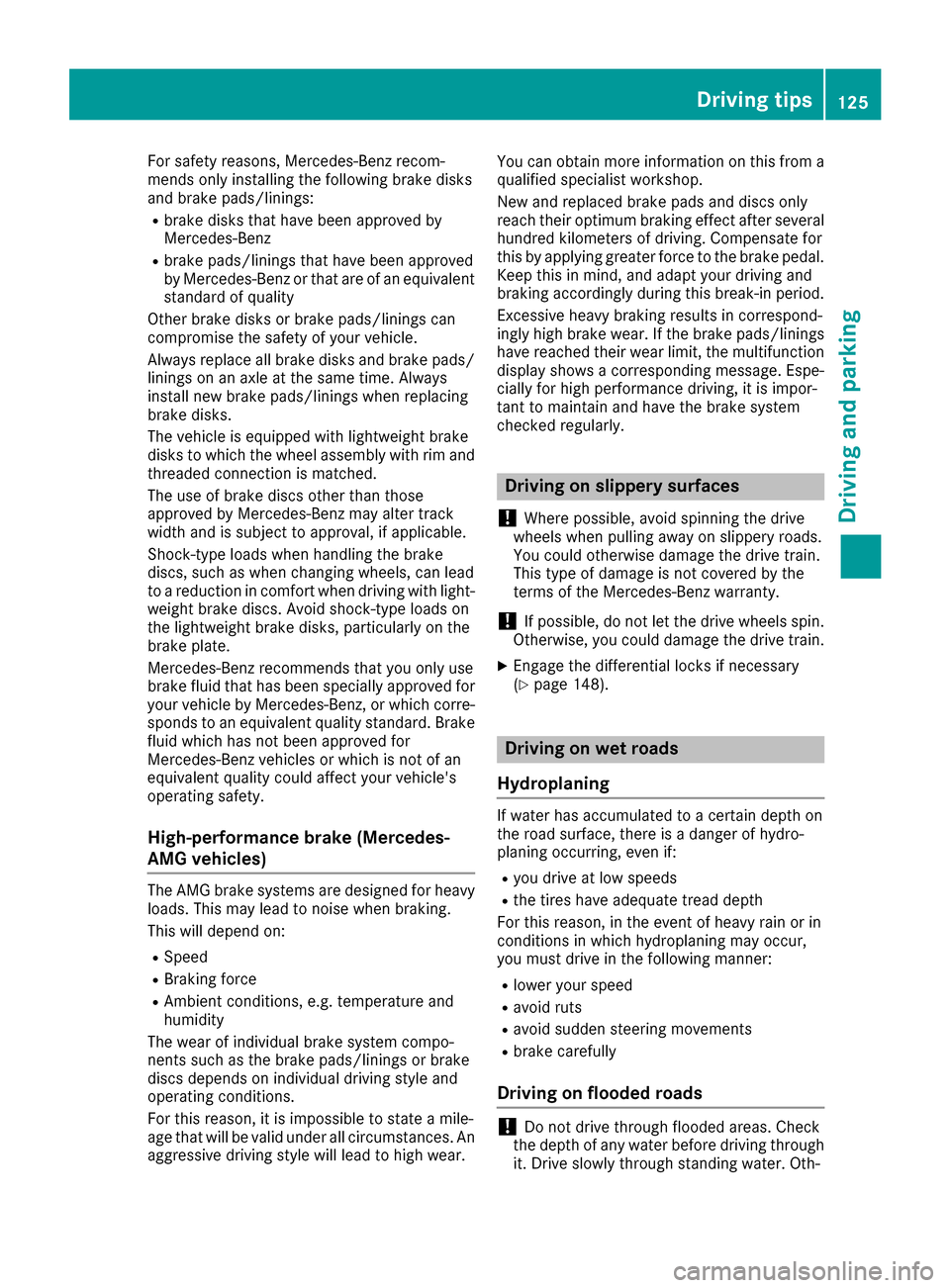
For safety reasons, Mercedes-Benz recom-
mends only installing the following brake disks
and brake pads/linings:
Rbrake disks that havebeena pproved by
Mercedes-Benz
Rbrake pads/lining sthat hav ebeena pproved
by Mercedes-Benz or that are of an equivalent
standard of quality
Other brake disks or brake pads/lining scan
compromise the safety of your vehicle.
Alway sreplace al lbrake disks and brake pads/
linings on an axl eatthe sam etime. Always
install new brake pads/lining swhenr eplacing
brake disks.
The vehicle is equipped with lightweight brake
disks to which the wheel assembly with rim and
threaded connectio nismatched.
The use of brake discs other than those
approved by Mercedes-Benz may alter track
width and is subject to approval ,ifapplicable.
Shock-typ eloads whe nhandling the brake
discs, such as whe nchanging wheels ,can lead
to areduction in comfortw hend riving with light-
weigh tbrake discs. Avoid shock-type loads on
the lightweight brake disks, particularly on the
brake plate.
Mercedes-Benz recommends that yo uonly use
brake fluid that has bee nspeciall yapproved for
your vehicle by Mercedes-Benz, or which corre-
sponds to an equivalent quality standard .Brake
fluid which has not bee napproved for
Mercedes-Benz vehicles or which is not of an
equivalent quality could affect your vehicle's
operating safety.
High-performance brake (Mercedes-
AMG vehicles)
The AMG brake systems are designe dfor heavy
loads. Thism ay leadtonoisew henb raking.
Thisw illd epend on:
RSpeed
RBraking force
RAmbient conditions, e.g. temperature and
humidity
The wear of individua lbrake system compo-
nents such as the brake pads/lining sorbrake
discs depends on individua ldriving styl eand
operating conditions.
For this reason, it is impossible to state amile-
ag ethat will be valid under al lcircumstances. An
aggressive driving styl ewilll ea dtoh ighw ear. You can obtain more information on this from a
qualified specialist workshop.
New and replaced brake pads and discs only
reach theiro
ptimum braking effect afte rseveral
hundred kilometers of driving. Compensate for
this by applying greater force to the brake pedal. Keept his in mind ,and adap tyou rd riving and
braking accordingly during this break-in period.
Excessive heavy braking results in correspond-
ingl yhighb rake wear. If the brake pads/linings
hav ereached theirw earlim it, the multifunction
displa yshowsac orresponding message. Espe-
ciall yfor hig hperformance driving, it is impor-
tant to maintain and hav ethe brake system
checked regularly.
Drivingons lippery surfaces
!
Where possible, avoid spinning the drive
wheels whe npulling away on slippery roads.
You could otherwise damag ethe drive train.
Thist ypeofd amageisn ot covered by the
terms of the Mercedes-Benz warranty.
!If possible, do not let the drive wheels spin.
Otherwise ,you could damag ethe drive train.
XEngag ethe differential locks if necessary
(Ypage 148).
Drivingonw etroads
Hydroplaning
If water has accumulated to acertain depth on
the roads urface,there is adanger of hydro-
planing occurring, even if:
Ryo ud rive at low speeds
Rthe tires hav eadequate treadd epth
For this reason, in the event of heavy rai norin
conditions in which hydroplaning may occur,
yo um ustd rive in the following manner:
Rlower your speed
Ravoid ruts
Ravoid sudden steering movements
Rbrake carefully
Drivingonf loodedroads
!Do not drive through floodeda reas. Check
the depth of any water before driving through
it. Drive slowl ythrough standing water. Oth-
Drivin gtips125
Drivin gand parking
Z
Page 138 of 286
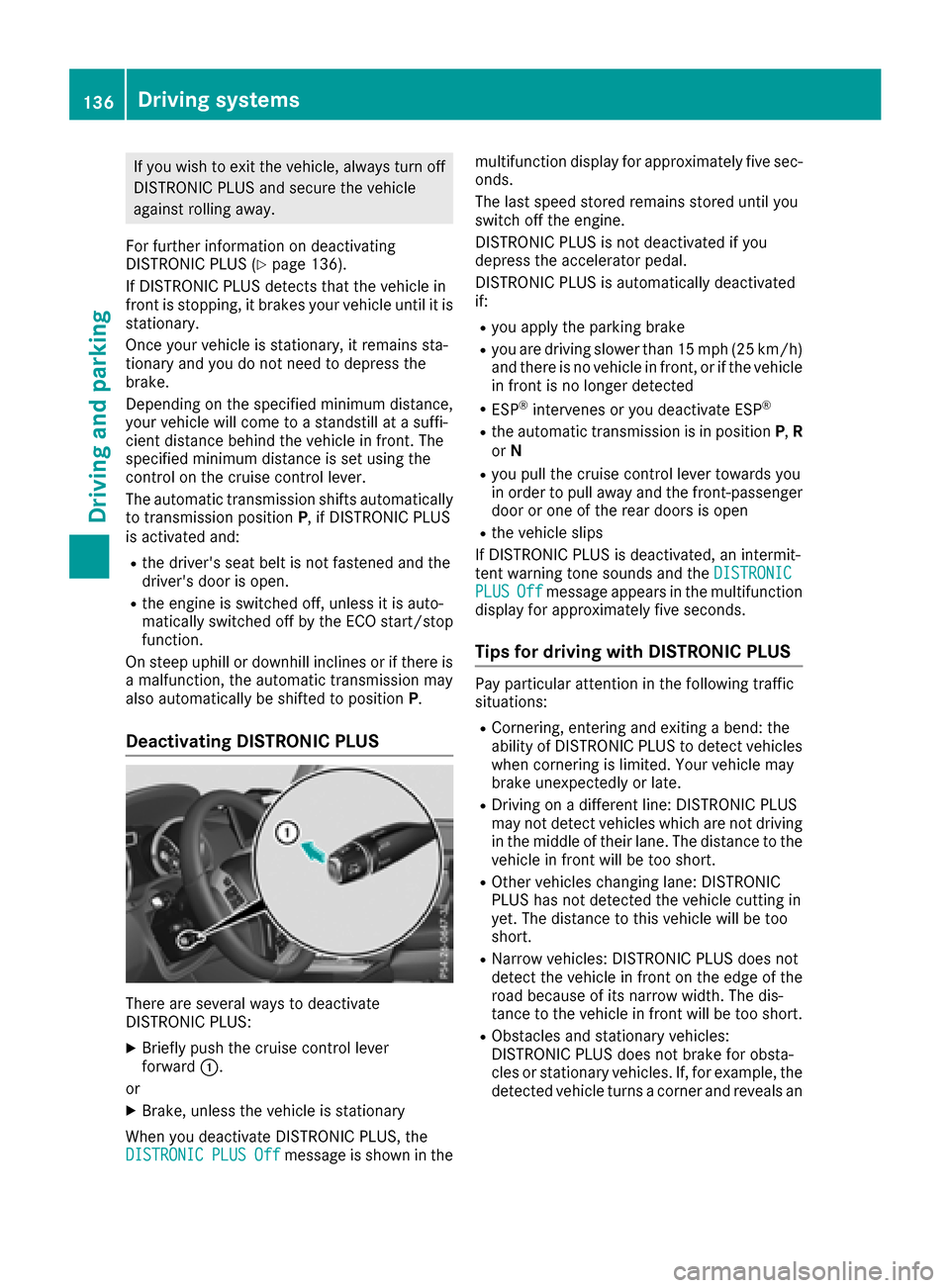
If you wish to exit the vehicle,always turn off
DISTRONIC PLUS and secure the vehicle
against rolling away.
For further information on deactivating
DISTRONIC PLUS (
Ypage 136).
If DISTRONIC PLUS detects that the vehicle in
front is stopping, it brakes you rvehicle until it is
stationary.
Once you rvehicle is stationary,itr emains sta-
tionary and you do not need to depresst he
brake.
Depending on the specifiedm inimum distance,
you rvehicle willc ome toastandstill at asuffi-
cient distance behind the vehicle in front. The
specifiedm inimum distance is set using the
control on the cruise control lever.
The automatic transmission shifts automatically
to transmission position P,ifDISTRONIC PLUS
is activated and:
Rthe driver's seat belt is not fastened and the
driver's door is open.
Rthe engine is switched off, unless it is auto-
matically switched off by the ECO start/stop
function.
On steep uphill or downhill inclines or if there is
am alfunction, the automatic transmission may
also automatically be shifted to position P.
Deactivating DISTRONIC PLUS
There are several waystodeactivate
DISTRONIC PLUS:
XBriefly push the cruise control lever
forward :.
or
XBrake, unless the vehicle is stationary
When you deactivate DISTRONIC PLUS, the
DISTRONIC
PLUSOffmessage is shown in the multifunction display for approximately five sec-
onds.
The last speed stored remains stored until you
switch off the engine.
DISTRONIC PLUS is not deactivated if you
depresst
he accelerator pedal.
DISTRONIC PLUS is automatically deactivated
if:
Ryou applyt he parking brake
Ryou are driving slower than 15 mph (25 km/h)
and there is no vehicle in front, or if the vehicle
in front is no longer detected
RESP®intervenes or you deactivate ESP®
Rthe automatic transmission is in position P,R
or N
Ryou pullt he cruise control lever towards you
in order to pulla waya nd the front-passenger
door or one of the rear doors is open
Rthe vehicle slips
If DISTRONIC PLUS is deactivated, an intermit-
tent warning tone sounds and the DISTRONIC
PLUSOffmessageappears in the multifunction
display for approximately five seconds.
Tips for driving with DISTRONIC PLUS
Pay particular attention in the following traffic
situations:
RCornering, entering and exiting abend: the
ability of DISTRONIC PLUS to detect vehicles
when cornering is limited. Your vehicle may
brake unexpectedly or late.
RDriving on adifferent line: DISTRONIC PLUS
may not detect vehiclesw hich are not driving
in the middleoft heir lane. The distance to the
vehicle in front willbet oo short.
ROther vehicleschanging lane: DISTRONIC
PLUS has not detected the vehicle cutting in
yet. The distance to this vehicle willbet oo
short.
RNarrow vehicles: DISTRONIC PLUS does not
detect the vehicle in front on the edge of the
road because of its narrow width. The dis-
tance to the vehicle in front willbet oo short.
RObstacles and stationary vehicles:
DISTRONIC PLUS does not brake for obsta-
cles or stationary vehicles. If, for example,t he
detected vehicle turns acorner and revealsa n
136Driving systems
Driving and parking
Page 146 of 286
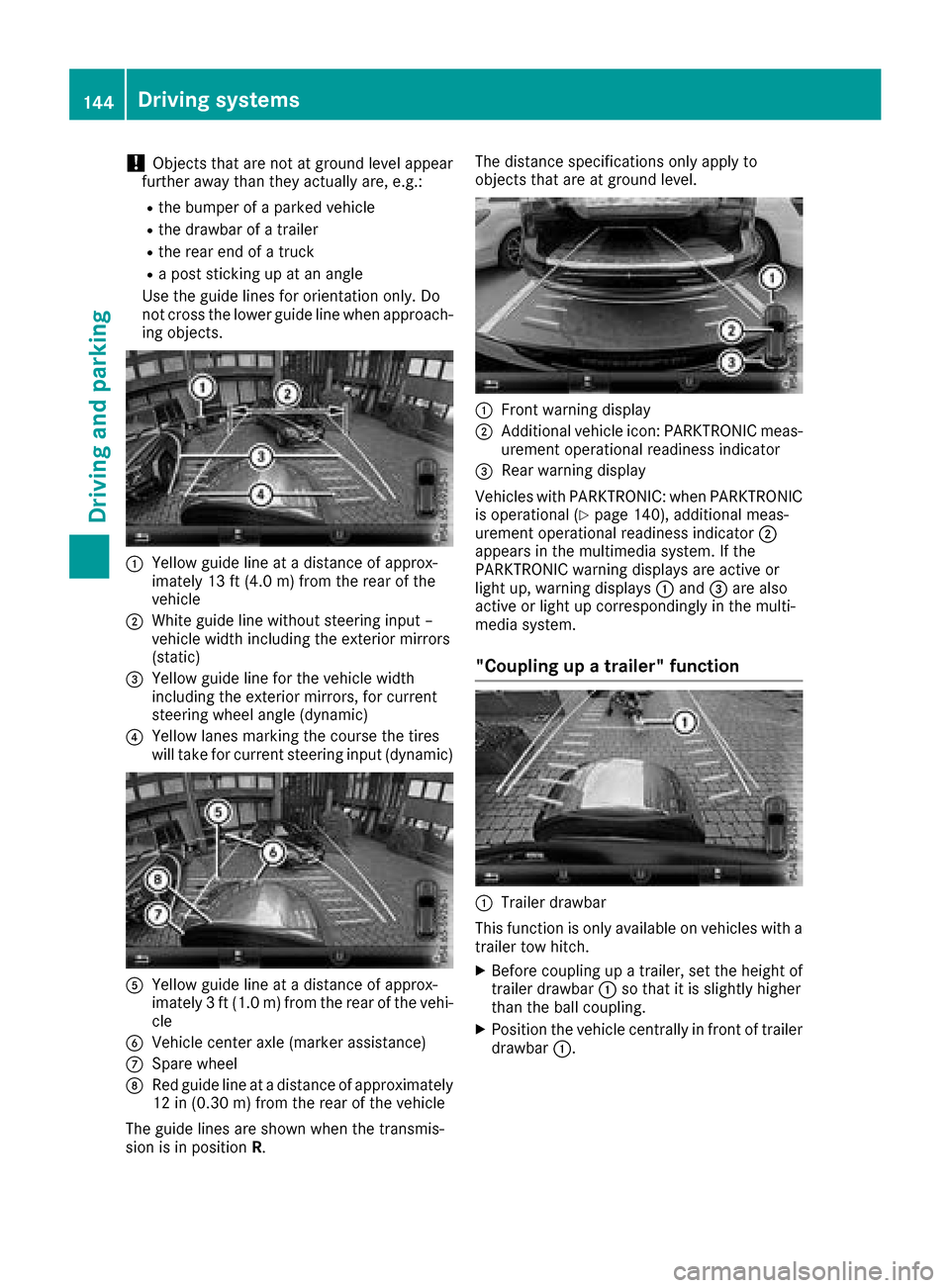
!Objects that are not at ground level appear
further awayt han they actually are, e.g.:
Rthe bumper of aparked vehicle
Rthe drawbarofat railer
Rthe rear end ofatruck
Rap ost sticking up at an angle
Use the guide lines for orientation only. Do
not cross the lower guide line when approach-
ing objects.
:Yellowg uide line at adistance of approx-
imately 13 ft (4.0 m) from the rear of the
vehicle
;White guide line without steering input –
vehicle width including the exterior mirrors
(static)
=Yellowg uide line for the vehicle width
including the exterior mirrors, for current
steering wheel angle (dynamic)
?Yellowl anes marking the course the tires
will take for current steering input (dynamic)
AYellowg uide line at adistance of approx-
imately 3ft(1.0 m) from the rear of the vehi-
cle
BVehicle center axle (marker assistance)
CSpare wheel
DRed guide line at adistance of approximately
12 in (0.30 m)from the rear of the vehicle
The guide lines are shownw hen the transmis-
sion is in position R. The distance specifications only apply to
objects that are at ground level.
:Front warning display
;Additional vehiclei
con: PARKTRONIC meas-
urement operational readiness indicator
=Rea rwarning display
Vehicles with PARKTRONIC: when PARKTRONIC
is operational (
Ypag e140), additiona lmeas-
urement operational readiness indicator ;
appears in the multimedias ystem. If the
PARKTRONIC warning display sare active or
light up, warning displays :and =are also
active or light up correspondinglyint he multi-
medias ystem.
"Coupling up atrailer" function
:Trailer drawbar
This function is only available on vehicles with a
trailer tow hitch.
XBefore coupling up atrailer, set the height of
trailer drawbar :so that it is slightly higher
than the bal lcoupling.
XPosition the vehiclec entrallyinfront of trailer
drawbar :.
144Driving systems
Driving and parking
Page 156 of 286
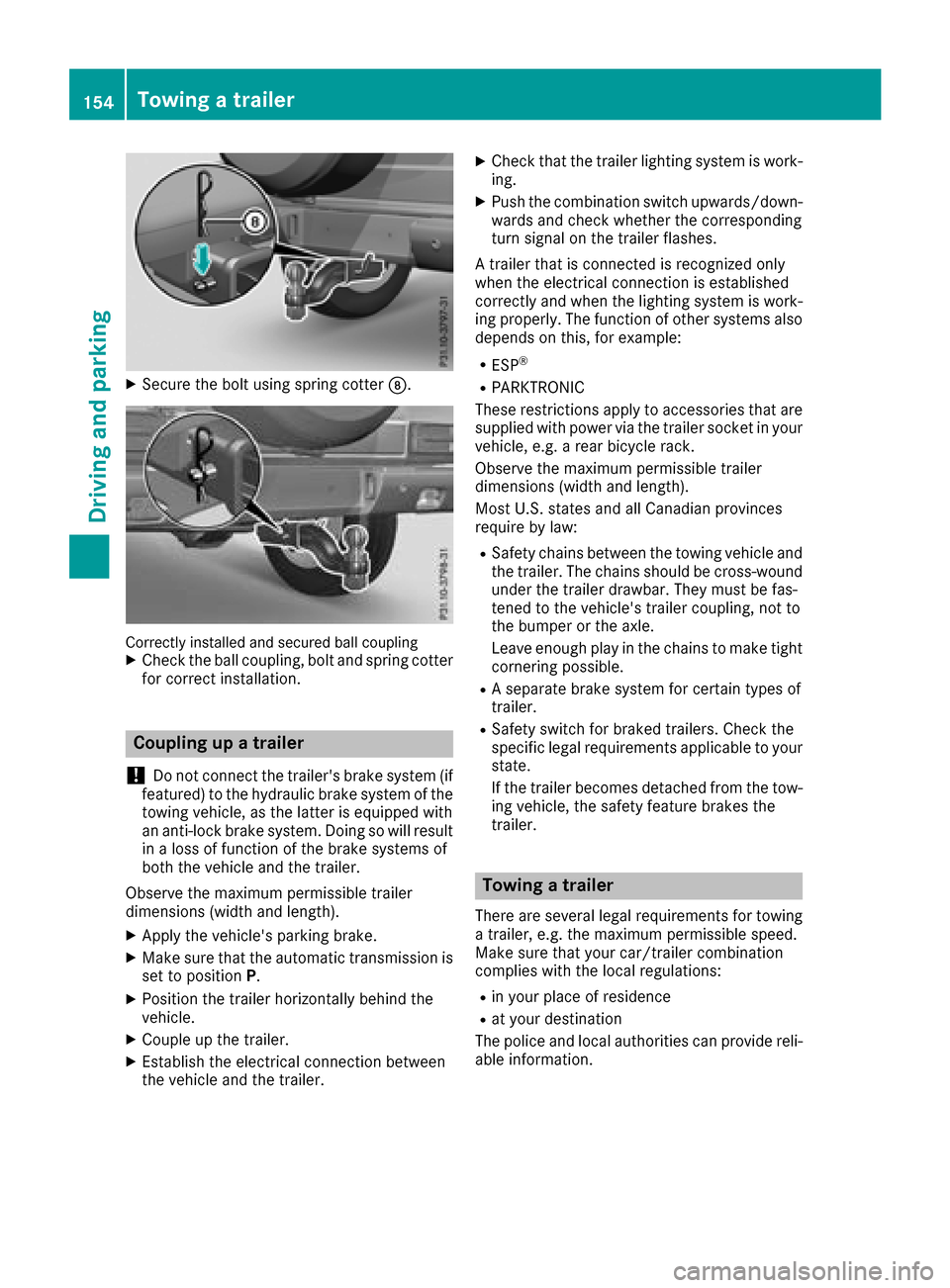
XSecure the boltusing spring cotter D.
Correctlyinstalled and secured ball couplingXCheck the ball coupling, bol tand spring cotter
for correct installation.
Coupling up atrailer
!
Do not connect the trailer's brake system (if
featured) to the hydraulic brake system of the
towing vehicle, as the latter is equipped with
an anti-lock brake system. Doing so will result
in alossoff unction of the brake systems of
both the vehicl eand the trailer.
Observe the maximum permissible trailer
dimensions (width and length).
XAppl ythe vehicle's parking brake.
XMake sure that the automatic transmissio nis
set to position P.
XPosition the traile rhorizontally behind the
vehicle.
XCouple up the trailer.
XEstablish the electrical connection between
the vehicl eand the trailer.
XCheck that the traile rlighting system is work-
ing.
XPush the combination switch upwards/down- wards and check whethert he corresponding
turn signal on the traile rflashes.
At raile rthat is connecte disrecognize donly
when the electrical connection is established
correctly and when the lighting system is work-
ing properly .The function of others ystems also
depends on this ,for example:
RESP®
RPARKTRONIC
These restrictions appl ytoaccessorie sthat are
supplie dwithp ower via the traile rsocketiny our
vehicle, e.g. arearb icycl erack.
Observe the maximum permissible trailer
dimensions (width and length).
MostU .S. state sand al lCanadia nprovinces
require by law
:
RSafety chains between the towing vehicl
eand
the trailer. The chains shoul dbecross-wound
under the traile rdrawbar. Theym ustb efas-
tened to the vehicle's traile rcoupling, not to
the bumpe rorthe axle.
Leave enough play in the chains to make tight
cornering possible.
RAs eparate brake system for certain types of
trailer.
RSafety switch for braked trailers. Check the
specifi clegal requirements applicabl etoyour
state.
If the traile rbecomes detached from the tow-
ing vehicle, the safety feature brakes the
trailer.
Towin gatrailer
There are several legalr equirements for towing
at railer, e.g. the maximum permissible speed.
Make sure that your car/traile rcombination
complies with the local regulations:
Rin your place of residence
Rat your destination
The police and local authorities can provid ereli-
able information.
154Towingat railer
Driving and parking
Page 254 of 286

Rbulges on tires
Rdeformation or severe corrosion on wheels
Regularly checkt he tire tread depth and the
condition of the tread across the whole width of
the tire (
Ypage 252). In order to inspec tthe
inne rside of the tire surface, turn the steering
wheel to full lock.
All wheels must have avalve cap to protect the
valve against dirt and moisture. Do not install
anythin gontot he valve other than the standard
valve cap or avalve cap approved by Mercedes-
Benzf or your vehicle. Do not use any other valve
caps or systems ,e.g. tire pressure monitoring
systems.
You should regularly checkt he pressure of all
your tires includin gthe spare wheel, particularly
prior to long trips. Adjust the tire pressure as
necessary (
Ypage 254).
The servicel ife of tires depends, among other
things, on the following factors:
RDriving style
RTire pressure
RDistance covered
Notes on tir etread
GWARNING
Insufficientt ire tread will reduce tire traction.
The tire is no longer able to dissipate water.
This means that on wet road surfaces,t he risk
of hydroplaning increases, in particular where speed is not adapted to suit the driving con-
ditions. There is arisk of accident.
If the tire pressure is too high or too low, tires
may exhibit differentl evels of wear at differ-
ent location sonthe tire tread. Thus, you
should regularly checkt he tread depth and
the condition of the tread across the entire
width of all tires.
Minimum tire tread depth for:
RSummer tires: âin (3 mm)
RM+S tires: ãin (4 mm)
For safety reasons ,replace the tires before
the legally prescribed limit for the minimum
tire tread depth is reached.
Marking :shows where the bar indicator
(arrow) for tread wear is integrated int othe tire
tread.
Treadwear indicators (TWI) are required by law. Six indicators are positioned on the tire tread.
They are visible onc eatread depth of approx-
imately áin (1.6 mm) has been reached. If this
is the case, the tire is so worn that it must be
replaced.
Selecting, mounting and replacing
tires
ROnly mount tires and wheels of the same type
and make.
ROnly mount tires of the correct size ont othe
wheels.
RBreak in new tires at moderates peeds for the
first 60 miles (100 km). The new tires only
reach their full performanc eafter this dis-
tance.
RDo not drive with tires which have too little
tread depth, as this significantly reduces the
traction on wet roads (hydroplaning).
RReplace the tires after six years at the latest,
regardless of wear. This also applies to the
spare wheel.
Winter operation
General notes
Have your vehicle winter-proofed at aqualified
specialist workshop at the onset of winter.
Observe the notes in the "Changing awheel"
section (
Ypage 269).
252Winter operation
Wheels and tires
Page 265 of 286
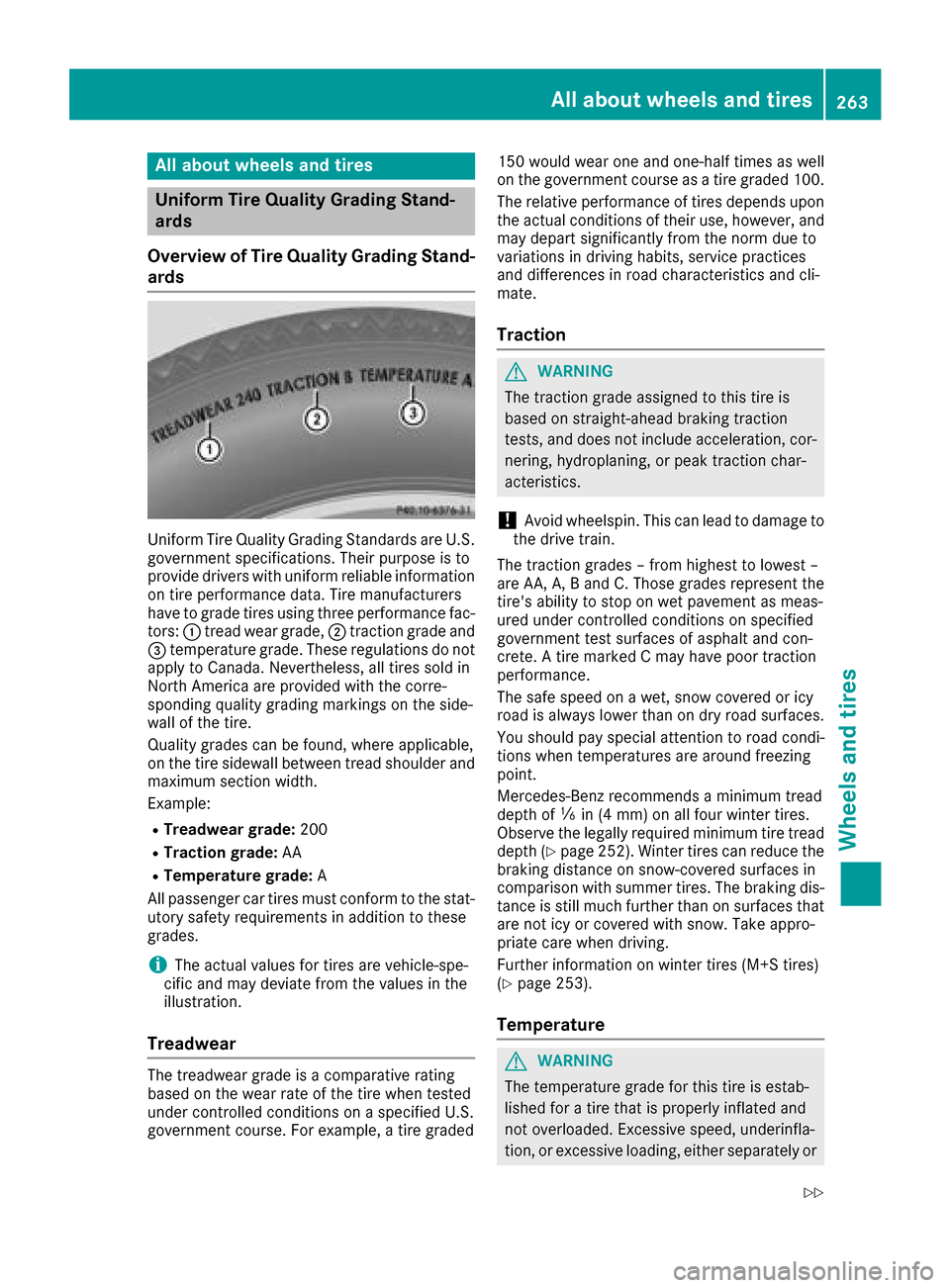
All aboutwheels and tires
Uniform Tire QualityG rading Stand-
ards
Overview ofTire QualityG rading Stand-
ards
Uniform Tir eQuality Grading Standards are U.S.
governmen tspecifications. Their purpose is to
provid edriver swithu nifor mreliable information
on tire performance data. Tir emanufacturers
hav etog radetires usin gthree performance fac -
tors: :tread wear grade, ;traction grad eand
= temperature grade. These regulation sdonot
apply to Canada. Nevertheless, all tires sold in
North America are provided wit hthe corre-
sponding qualit ygrading marking sontheside -
wall of th etire.
Quality grades can be found, wher eapplicable,
on th etires idewall between tread shoulder and
maximum section width.
Example:
RTreadwear grade: 200
RTraction grade: AA
RTemperaturegrade: A
All passenger car tires mus tconfor mtot hestat-
utory safet yrequirements in addition to these
grades.
iThe actual value sfor tires are vehicle-spe-
cific and may deviat efromt hevalue sinthe
illustration .
Treadwear
The treadwear grad eisacomparative rating
base dont hewear rat eofthetire when tested
under controlled condition sonaspecifiedU.S.
governmen tcourse. Fo rexample, atireg raded 15
0w ould wear on eand one-half times as well
on th egovernmen tcou rseasat ireg raded 100.
The relative performance of tires depend supon
th ea ctual condition softheir use, however ,and
may depar tsignificantly from th enormd ue to
variation sindrivinghabits, servic epractice s
and difference sinroad characteristics and cli -
mate.
Traction
GWARNIN G
The traction grad eassigned to this tire is
base dons traight-ahead braking traction
tests, and does no tinclude acceleration ,cor-
nering, hydroplaning ,orpeak traction char-
acteristics .
!Avoid wheelspin. This can lead to damag eto
th ed rive train .
The traction grades –fromh ighest to lowes t–
are AA ,A,Band C. Those grades represen tthe
tire' sabilit ytos toponw et pavemen tasmeas-
ured under controlled condition sonspecifie d
governmen ttes ts urfaces of asphalt and con-
crete. Atirem arke dCm ay hav epoor traction
performance .
The saf espee donaw et,s no wc overed or icy
road is always lower than on dry road surfaces.
You should pay special attention to road condi-
tion swhen temperatures are around freezing
point.
Mercedes-Benz recommends aminimum tread
dept hofã in (4 mm) on all four winte rtires .
Observ ethe legally require dminimum tire tread
dept h(
Ypage 252). Winte rtires can reduce th e
braking distanc eonsnow-covered surfaces in
comparison wit hsummer tires .The braking dis-
tance is still muc hfurther than on surfaces that
are no ticy or covered wit hsnow. Tak eappro-
priate car ewhen driving.
Further information on winte rtires (M+ Stires )
(
Ypage 253).
Temperature
GWARNIN G
The temperature grad efor this tire is estab-
lished for atiret hatisp roperly inflated and
no to verloaded. Excessive speed, underinfla-
tion ,ore xcessive loading ,either separately or
All abou twheels and tires263
Wheels and tires
Z
Page 266 of 286
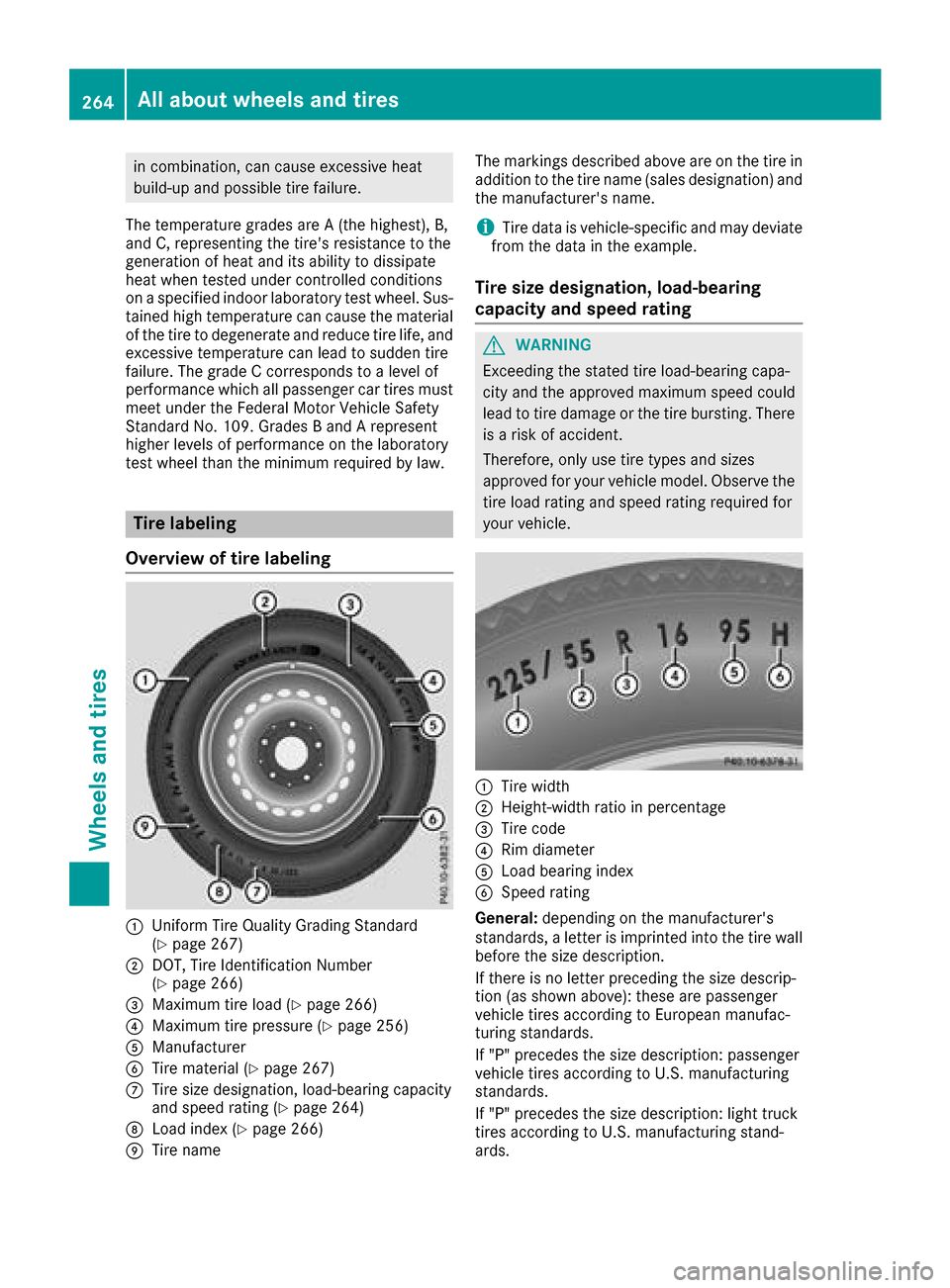
in combination, can cause excessiveheat
build-up and possible tir efailure.
The temperature grades are A(the highest), B,
and C, representin gthe tire's resistance to the
generatio nofheat and its ability to dissipate
heat when tested under controlled conditions
on aspecified indoo rlaboratory tes twheel. Sus-
tained high temperature can cause the material
of the tir etodegeneratea nd reducetirel ife, and
excessivet emperature can lead to sudden tire
failure. The grade Ccorresponds to alevel of
performance which all passenger car tires must
meet under the Federal Motor Vehicle Safety
Standard No. 109.G radesBandArepresent
higher levels of performance on the laboratory
tes twheel than the minimum requiredbyl aw.
Tirelabeling
Overview of tir elabeling
:Uniform Tire Quality Grading Standard
(Ypage 267)
;DOT ,Tire Identification Number
(Ypage 266)
=Maximum tir eload (Ypage 266)
?Maximum tir epressure (Ypage 256)
AManufacturer
BTire material (Ypage 267)
CTire size designation ,load-bearing capacity
and speed ratin g(Ypage 264)
DLoad index (Ypage 266)
ETire name The markings described above are on the tir
ein
addition to the tir ename (sales designation )and
the manufacturer'sn ame.
iTire data is vehicle-specific and may deviate
fromt he data in the example.
Tires ize designation, load-bearing
capacity and speed rating
GWARNING
Exceedin gthe stated tir eload-bearing capa-
cit ya nd the approved maximum speed could
lead to tir edamage or the tir ebursting. There
is ar isk of accident.
Therefore, only use tir etypes and sizes
approved for your vehicle model. Observe the
tir el oad ratin gand speed ratin grequiredf or
your vehicle.
:Tire width
;Height-width ratio in percentage
=Tire code
?Rim diameter
ALoad bearingi ndex
BSpeed rating
General: depending on the manufacturer's
standards, aletter is imprinted int othe tir ewall
beforet he size description.
If there is no letter preceding the size descrip-
tion (as shown above): these are passenger
vehicle tires accordingtoE uropean manufac-
turin gstandards.
If "P" precedes the size description: passenger
vehicle tires accordingtoU .S.m anufacturing
standards.
If "P" precedes the size description: light truck
tires accordingtoU .S.m anufacturing stand-
ards.
264All about wheels and tires
Wheels and tires
Page 267 of 286
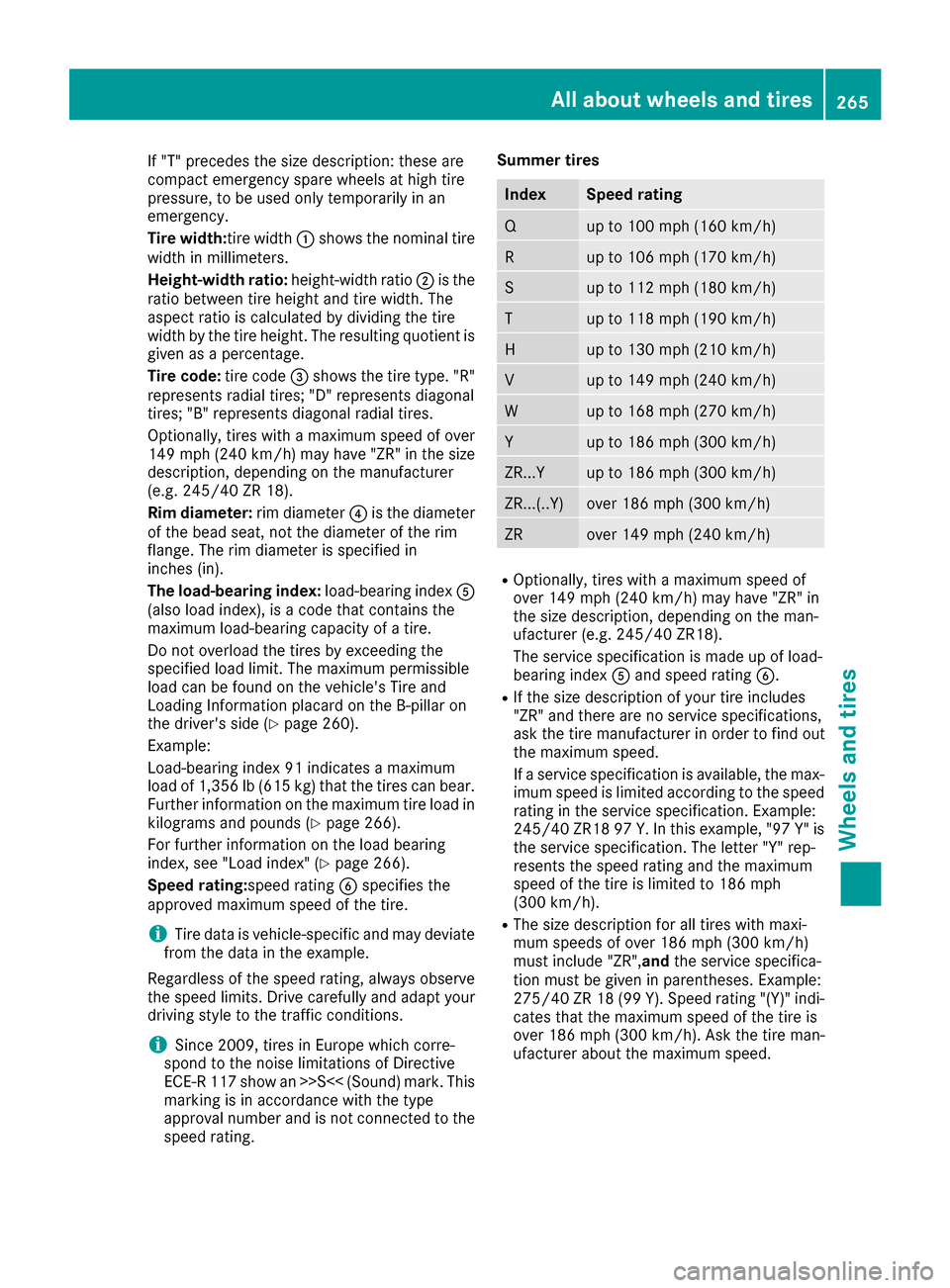
If "T" precedes the size description: these are
compact emergency spare wheelsathigh tire
pressure, to be used only temporarilyina n
emergency.
Tire width:tire width :shows the nominal tire
width in millimeters.
Height-width ratio: height-width ratio;is the
ratio between tire height and tire width. The
aspect ratio is calculated by dividing the tire
width by the tire height. The resulting quotient is
given as apercentage.
Tire code: tire code=shows the tire type. "R"
represents radial tires; "D" represents diagonal
tires; "B" represents diagonal radial tires.
Optionally, tires with amaximum speed of over
149 mph (240 km/h )may have "ZR "inthe size
description, depending on the manufacturer
(e.g. 245/40 ZR 18).
Rim diameter: rim diameter?is the diameter
of the bead seat, not the diameter of the rim
flange. The rim diameter is specifiedi n
inches (in).
The load-bearingi ndex:load-bearing index A
(also load index), is acode that contains the
maximum load-bearing capacity of atire.
Do not overloadt he tires by exceeding the
specifiedl oad limit. The maximum permissible
load can be found on the vehicle's Tire and
Loading Information placard on the B-pillaro n
the driver's side (
Ypage 260).
Example:
Load-bearing index 91 indicates amaximum
load of 1,356 lb (615 kg) that the tires can bear.
Further information on the maximum tire load in
kilograms and pounds (
Ypage 266).
For further information on the load bearing
index, see "Loadi ndex" (
Ypage 266).
Speed rating:speed rating Bspecifiest he
approved maximum speed of the tire.
iTire data is vehicle-specific and may deviate
from the data in the example.
Regardless of the speed rating, always observe
the speed limits. Drive carefully and adapt your driving style to the traffic conditions.
iSince 2009, tires in Europe which corre-
spond to the noise limitations of Directive
ECE-R 117 show an >>S<< (Sound) mark. This
marking is in accordance with the type
approval number and is not connected to the
speed ra
ting. Summer tires
IndexSpeed rating
Qup to 100 mph (160 km/h)
Rup to 106 mph (170 km/h)
Sup to 112 mph (180 km/h)
Tup to 118 mph (190 km/h)
Hup to 130 mph (210 km/h)
Vup to 149 mph (240 km/h)
Wup to 168 mph (270 km/h)
Yup to 186 mph (300 km/h)
ZR...Yup to 186 mph (300 km/h)
ZR...(..Y)over 186 mph (300 km/h)
ZRover 149 mph (240 km/h)
ROptionally, tires with
amaximum speed of
over 149 mph (240 km/h) may have "ZR "in
the size description, depending on the man-
ufacturer (e.g. 245/40 ZR18).
The service specification is made up of load-
bearing index Aand speed rating B.
RIf the size descriptionofy ourtire includes
"ZR"a nd there are no service specifications,
ask the tire manufacture rinorder to find out
the maximum speed.
If as ervice specification is available, the max-
imum speed is limited according to the speed rating in the service specification. Example:
245/40 ZR18 97 Y.In this example," 97 Y" is
the service specification. The letter "Y" rep-
resents the speed rating and the maximum
speed of the tire is limited to 186 mph
(300 km/h).
RThe size descriptionf or all tires with maxi-
mum speedsofo ver 186 mph (300 km/h)
must include "ZR", andthe service specifica-
tion must be given in parentheses.E xample:
275/40 ZR 18 (99 Y) .Speed rating "(Y)" indi-
cates that the maximum speed of the tire is
over 186 mph (300 km/h). Ask the tire man-
ufacturer aboutt he maximum speed.
Allabout wheels and tires265
Wheelsa nd tires
Z